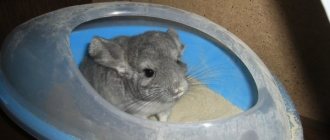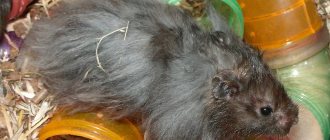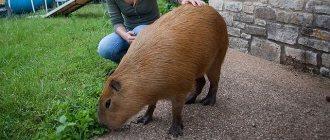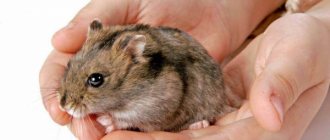Sand for hamsters is more of a luxury than a necessity.
However, having seen at least once how excitedly a Djungarian hamster bathes in the sand, the owner is ready to provide his pet with such a bath on an ongoing basis. Many questions immediately arise: what kind of sand is needed, how often can you bathe, how does this affect the health of the animal. In nature, you can often observe birds cleaning their feathers in the dust. Owners of parrots and chinchillas must provide their pets with sand bathing. Sand acts as a “dry shampoo”, effectively cleansing fur (feathers) and skin, helping to get rid of skin parasites, lost hairs and moisture. Wild rodents do not neglect this procedure, so a sand bath for a domestic hamster will be useful.
Benefits of sand baths
All domesticated animals must be kept in conditions close to natural ones. How do wild hamsters clean their fur of excess fat and dirt? That's right - wallowing in the sand! This method of bathing is safe and enjoyable. Therefore, sand is very important for a hamster.
Here are the positive differences between sand baths and water procedures:
- after bathing in the sand, there is no need to dry the animal’s fur;
- During sand bathing and after the procedure, the body does not become hypothermic, therefore, the possibility of catching a cold is zero;
- bathing a hamster in dry litter does not cause fear or panic in the animal, quite the opposite: for rodents it is a very fun activity;
- sand for a hamster can also become a sporting activity.
As you can see, sand baths are very beneficial for your furry friend. But in order for the fur cleansing procedure to be safe, the sand must be selected correctly.
Sand bath for a hamster
Hamsters do not tolerate contact with water well, so standard bath procedures are contraindicated for them. To keep rodents' fur clean, it is recommended that they periodically give sand baths. With the right approach, such bathing is very useful for ornamental pets.
Angora and Syrian hamsters use sand baths to keep their coats clean and get rid of dead hairs and dead skin particles. But their Dzungarian relatives perceive procedures not only as a method of hygiene, but also as entertainment.
On a note. Sand baths reduce the risk of catching a cold and are a great way to warm up.
However, such procedures also have disadvantages:
- If the bathing suit is left in the cage for a long time, the animal will quickly turn it into a toilet. Contaminated wet grains of sand will begin to stick to the rodent's fur and begin to stain it.
- Excessive use of such baths can lead to drying out of the animal’s skin, as a result of which it will lose its protective properties.
What kind of sand does a hamster need?
For the Syrian hamster, Djungarian hamsters and representatives of other breeds, the requirements for filler are the same. They are based on safety and hygiene parameters.
Here are the requirements that sand for a hamster must meet:
- Uniformity. Sand particles must be the same size.
- Optimal size. The sand should not be too large so as not to prick the baby's paws. But you shouldn’t buy sand that is too fine for your hamster: it contains a lot of dust, which will get into the furry’s eyes and nose, causing sneezing and conjunctivitis.
- Sterility. It is better to buy bath filler in pet stores, because street sand is quite dirty and contains a whole bunch of microorganisms, some of which may be pathogenic. Untreated soil from the street or river can cause pulmonary ailments, skin diseases and inflammation of the mucous membranes.
- Purity. The sand in the bathing suit needs periodic replacement.
The same bath filler that is sold for chinchillas in specialized stores is well suited for a hamster. If bathing is done infrequently, then the packaging will last for a long time. But if your finances are really bad, you can collect some fine sand from the river. Before use, it should be carefully prepared: rinse with hot water several times, then heat in a frying pan (disinfection) and dry.
We buy sand
Sand bath filler is sold in pet stores. You won’t find sand specifically for hamsters, so pay your attention to sand for chinchillas. It is quite fine, but not dusty. It will be useful to know how much sand for hamsters costs. The price range is quite wide. It depends on the brand and weight of the filler.
Usually 1 kg of sand is enough for six months for dzhungarikas and other small breeds. For Syrian hamsters, a kilogram will last for 3-4 months, depending on the frequency of bathing.
To find out how much hamster sand costs and which brands are the best, check reviews from breeders. Professionals recommend paying attention to the following brands:
- Vitakraft chinchilla sandy. Perfectly cleans rodent fur and makes it shiny. This filler needs to be changed weekly. The product is quite expensive; for 1 kg you will have to pay 400 rubles.
- Padovan bathing send. Another expensive type of sand for hamsters. The manufacturer guarantees the absence of dust. A plastic package with a volume of 2 liters costs 490 rubles.
- JR FARM. A cheaper product, costs 330 rubles per 1 kg.
- Waka. Sand for hamsters produced in Russia is considered one of the cheapest. A package weighing 1.6 kg costs only 125 rubles!
- Little one. Another Russian brand. Sand for hamsters and chinchillas is available in a plastic jar weighing 1 kg. Costs from 250 rubles.
There are other types of sand that are produced in larger containers. But for a hamster, if he lives with you alone, it is not advisable to purchase a package weighing more than 3 kg.
Sand for bathing hamsters looks like this:
How to make a bathing suit for a rodent
A bathing bath for a hamster can be purchased at a pet store or built independently.
Selection of capacity
It is advisable to pour sand for hamsters into a stable container with transparent walls through which you can observe the process.
The container should be deep enough so that its contents do not spill across the floor of the room.
Perfect for organizing a swim:
- glass aquarium or terrarium;
- plastic container for wet wipes;
- deep ceramic plate;
- the lower part of the carrying container.
Which sand is suitable
Sand for a hamster should be uniform, clean, with medium-sized grains of sand. Large particles can injure the rodent's skin, while small particles enter the pet's respiratory tract and eyes.
Since pet stores do not sell special sand for hamsters, many owners use the products for other types of animals and birds. But such an alternative can harm the decorative rodent.
The following are absolutely not suitable for bathing a hamster:
- Ordinary sand, collected in a sandbox. It is a breeding ground for parasites and infections, and also contains garbage and various impurities.
- Sifted and calcined construction sand is also unsuitable for pouring into a bathing suit. Large particles scratch the rodent's skin and provoke the development of inflammatory processes.
- Sand for parrots. Activated carbon, crushed shells and other additives are mixed into it.
- Volcanic sand. It is a clay mineral powder and is harmful to rodents. Small and light grains of sand enter the hamster's respiratory tract and cause sneezing.
For a hamster, regular sand collected near a pond is suitable. But before filling the bathing suit with it, it must be thoroughly rinsed with hot water and dried in a hot oven.
The best option is sand for chinchillas, which does not contain talc. It contains round particles, quartz and sepiolite.
It is best to buy imported sand for your hamster:
- Vitakraft Sandy. German products costing 420 rubles. for 1 kg.
- JRFarm ChinchillaSand. It is produced in Germany and costs about 300 rubles. per pack weighing 1 kg.
- Beaphar XtraVital. It is produced in the Netherlands and costs around 600 rubles. per pack weighing 1.3 kg.
- Versele-Laga Chinchilla Bathing Sand. Belgian products costing 650 rubles. for 1.3 kg.
- Padovan Bathing Sand. Made in Italy and costs 580 rubles. for 1.3 kg.
Sand consumption for a hamster depends on the frequency of bathing and the size of the pet. A pack weighing 1 kg lasts on average for six months.
On a note. Sand for a hamster can be used in a bath repeatedly. To do this, after use, it is sifted, calcined in the oven and poured into an airtight container.
Sand bath
If you bought sand for your hamster, you also need a bath in which you will pour it. The following tools are suitable for this:
- old soap dish - for dzhungariks;
- ceramic dishes of various diameters;
- food containers;
- plastic jar of processed cheese;
- plastic tissue box.
You can make a bathtub from cardboard at home, but it won’t last long. And in general, you can use any unnecessary container for these purposes, the main thing is that it is suitable in size.
If funds allow, you can buy a special sand bath for your small rodents. This piece of furniture can also be ordered in the online store. Here are some popular models:
- Super Pet. Ceramic bathing suit for dwarfs. Miniature, does not take up much space. Durable, since the homa will not gnaw it. Price from 580 rubles.
- Savic wellness batc. Spacious bath for Syrian hamsters. Made from non-toxic plastic. The top is removable for easy cleaning. Cost from 660 rubles.
- Trixie. A plastic bathing suit that can also be used as a toilet. Length 17 cm, suitable for small rodents and young Syrians. Price – from 400 rubles.
- Super pet chinchilla bath house. This is a bathing house for chinchillas, which will also be comfortable for a Syrian hamster. The swimsuit is quite expensive, but it has an original design. Cost – from 1300 rubles.
Purchased sand baths are superior to homemade ones only in their design. If you don’t have extra money to buy a “bath”, you can get by with any box or bowl that is suitable in size.
Bath for hamsters
You need to choose a suitable container that will serve as a bath. You can choose any ceramic dishes, plastic food containers, plastic jars or soap dishes. It’s easy to make a bathing suit yourself from cardboard, but it won’t last long. Choose any container that is at least roughly the size of your hamster. You can also buy a bathing suit at a pet store.
Rules for using sand baths
In order for your furry miracle to like the procedure and benefit it, you need to know how to bathe a hamster in the sand. We have selected several recommendations for you:
- sand for bathing hamsters should be poured in a thick layer so that the animal can bury itself in it. For Djungarians and representatives of other small breeds it is 4-5 cm, for Syrians – 7 cm;
- There is no need to leave the bathing suits overnight: the homa will definitely pond the sand or cover it with garbage;
- Bathing a hamster in the sand can be done 1-2 times a week;
- weekly sand for hamsters must be replaced with fresh sand or calcined in a frying pan;
- The duration of the procedure should not exceed half an hour.
Usually hamsters immediately understand why they have a sand bath in their cage. But if your furry friend doesn’t understand what kind of object appeared in his house, then help him. Just put your funny animal in the bath, let him get used to it, sniff the filler. And then watch how the animal happily flounders and cleans its fur!
Now you know how to bathe your little hamster without using water. This method is safer, it does not cause inconvenience to the fluffy, and does not injure his psyche. Don’t forget to change the sand in the bath so that the bathing procedure does not lose its hygienic value!
Pros and cons of sand baths
Advantages
Sand for Djungarian hamsters is not only a hygienic procedure, but also physical activity and entertainment. And for the Syrian hamster, sand can replace real bathing. Long-haired (Angora) hamsters are washed more often than others to maintain their beauty, but washing is a lot of stress for them. Sand allows you to achieve softness and shine, keep the fur clean, removing dead skin flakes and fallen hairs.
Harm
Possible if bathing recommendations are not followed. If the bathing suit is constantly left in the cage, or baths are abused, the skin dries out and loses its protective properties. The hamster will relieve itself in the sand and then roll around in it. The mixture of feces and sand will stick to the fur rather than clean it.











